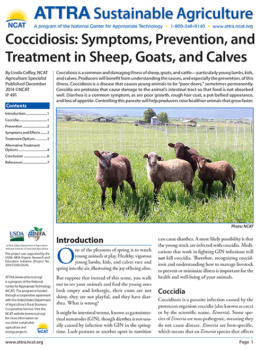Coccidiosis: Symptoms, Prevention, and Treatment in Sheep, Goats, and Calves
By Linda Coffey, NCAT Agriculture Specialist

Photo: NCAT
Abstract
Coccidiosis is a common and damaging illness of sheep, goats, and cattle—particularly young lambs, kids, and calves. Producers will benefit from understanding the causes, and especially the prevention, of this illness. Coccidiosis is a disease that causes young animals to be “poor doers,” sometimes permanently. Coccidia are protozoa that cause damage to the animal’s intestinal tract so that food is not absorbed well. Diarrhea is a common symptom, as are poor growth, rough hair coat, a pot-bellied appearance, and loss of appetite. Controlling this parasite will help producers raise healthier animals that grow faster.
Contents
Introduction
Coccidia
Prevention
Symptoms and Effects
Treatment Options
Alternative Treatment Options
Conclusion
References
Introduction
One of the pleasures of spring is to watch young animals at play. Healthy, vigorous young lambs, kids, and calves race and spring into the air, illustrating the joy of being alive.
But suppose that instead of this scene, you walk out to see your animals and find the young ones look empty and lethargic, their coats are not shiny, they are not playful, and they have diarrhea. What is wrong?
It might be intestinal worms, known as gastrointestinal nematodes (GIN), though diarrhea is not usually caused by infection with GIN in the springtime. Lush pastures or another upset in nutrition can cause diarrhea. A more likely possibility is that the young stock are infected with coccidia. Medications that work in fighting GIN infections will NOT kill coccidia. Therefore, recognizing coccidiosis and understanding how to manage livestock to prevent or minimize illness is important for the health and well-being of your animals.
Coccidia
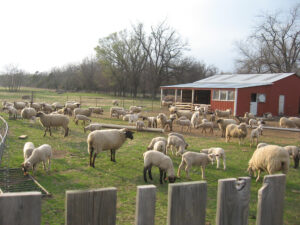
Crowded conditions lead to sanitation problems. Wet weather increases the risk of coccidiosis outbreaks in the young animals. Photo: NCAT
Coccidiosis is a parasite infection caused by the protozoan organism coccidia (also known as cocci or by the scientific name, Eimeria). Some species of Eimeria are non-pathogenic, meaning they do not cause disease. Eimeria are host-specific, which means that an Eimeria species that affects goats will not affect sheep or cattle, and vice versa. The manifestation of clinical signs of coccidiosis depends on the parasite (numbers, species), the host (age, stage of production, health condition, breed), and environmental conditions (climate, stress). Since immunity to the infection develops over time, young animals are more susceptible to infection and disease. It is normal for adults to harbor small numbers of coccidia without any signs of disease, and they are likely a source of infection for their offspring.
Coccidia have a very complex life cycle, with many steps and various stages at which intestinal cells are damaged. The cycle begins when oocysts are passed in feces and ingested by the animal. Once inside, the parasite invades cells and then reproduces and invades more cells. The original oocysts ingested can be multiplied many times and cause a great deal of damage to intestinal cells before the coccidia can be detected in the animals’ feces. Animals may die before showing any signs of coccidiosis if exposure is sudden and high (lots of oocysts in the young animals’ environment) and if the animals are stressed (Smith and Sherman, 1994; Daugschies and Najdrowski, 2005; Chartier and Paraud, 2012).
With more gradual exposure, an animal’s immune system can develop resistance that slows the rate of coccidial reproduction in the host’s intestinal tract. Developing this resistance takes time (five to six months). Afterward the animal will still pick up infections and shed coccidia in its feces, thus contaminating the environment, but it generally will not show signs of illness (Chartier and Paraud, 2012; Smith and Sherman, 1994).
Conditions that may lead to coccidiosis include the following:
- Young stock (three weeks to five months) (Smith and Sherman, 1994)
- Crowded
- Wet
- Unsanitary
- Stressful (including bad weather, poor handling practices, weaning, illness, poor nutrition)
Prevention
To prevent coccidiosis, make every effort to reduce stress on the animals and improve sanitation and living conditions. Dry bedding (replenished often with additional fresh, dry bedding) is helpful. This allows the mothers to lie down on clean places, keeping udders and teats cleaner. This helps reduce mastitis, as well as lowering risk of coccidiosis. Gravel or wood chips added to lots promotes dry areas. Provide shelter if weather is cold and rainy, handle animals calmly, and be aware that as the season progresses, numbers of coccidia are building. Clean water and feed troughs, and disinfect feed troughs if possible, to lessen exposure to cocci. Exposure to small numbers of cocci is actually beneficial, as it encourages the building of immunity. On the other hand, exposure to large numbers increases risk of infection (Chartier and Paraud, 2012; Smith and Sherman, 1994).
Several types of stresses can overwhelm immunity and cause animals to develop coccidiosis. Some examples of potential stresses are:
- Weather changes or extremes
- Transportation
- Nutritional challenges or feed changes
- Weaning
- Illness, including infection with gastrointestinal nematodes (GIN)
- Lactation
- Advanced age
- Increased levels of exposure to Eimeria
- Unsanitary environment
(Smith and Sherman, 1994)
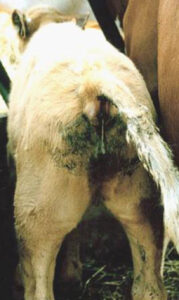
Coccidiosis is a devastating disease if not treated in time, leading to lifelong unthriftiness. Severe coccidiosis may result in dehydration and death. Photo: National Animal Disease Information Service (NADIS)
Symptoms and Effects
Probably the first sign of a problem with coccidiosis is diarrhea: hindquarters and tails may be coated with manure. Along with that, animals may show decreased appetite, listlessness, weakness, and abdominal pain (shown by crying or frequent repeated standing and lying). If the infection is not overwhelming, they may be sick for a couple of weeks and then get better. If the animals have been suddenly exposed to a large dose of coccidia and have no immunity, they may quickly dehydrate and die.
Although mortalities have a large impact on profitability of a livestock operation, the animals that recover from coccidiosis can experience more subtle and long-lasting effects that are even more costly. These effects include a general unthriftiness (failure to thrive), poor growth rate, poor milk production, and susceptibility to health problems due to damage to the intestines. To avoid these long-term consequences, producers will need to take preventive management measures to counteract the stressful conditions listed above. In some situations, however, these measures will prove difficult to accomplish. For example, a farm that has been raising young stock intensively for some years may have such a load of parasites that infection is inevitable. In that situation, further interventions may be required.
Treatment Options
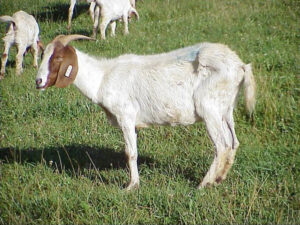
This goat stands in a typical posture of an animal suffering from coccidiosis. Photo: J.M. Luginbuhl, North Carolina State University
Consulting with your veterinarian is necessary to devise a coccidiosis treatment program, which may include the feeding of ionophores, treatment with sulfa drugs or amprolium, and/or using alternative treatments. Note that livestock that are treated with ionophores or other medications that are not approved for use in organic production systems cannot be certified organic. If it becomes necessary to use these medicines on a certified-organic animal to achieve effective treatment, that individual animal will lose its organic certification. Note also that most medications are not labeled for sheep or goats and, therefore, consulting your veterinarian is essential. Be sure to follow instructions carefully when using any treatment. Using medications in the wrong way will waste money and time and not solve the problem. For example, medications designed to act on early stages of the life cycle to disrupt the parasite (prevention) will not cure established infection. Also, preventive medications must be used at least 30 days before kidding or lambing to prevent the mothers from infecting the young. To be effective, preventive medications must also be used well before weaning to protect the young stock during that stressful event. Again, follow label instructions.
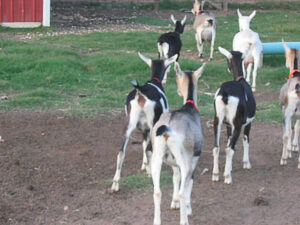
Examining animals as they walk away will help detect signs of coccidiosis. These goats are healthy, as evidenced by clean legs and tails and lively, alert behavior. Photo: NCAT
Failure to follow all directions will greatly reduce the impact of the drugs. Also, using medications improperly can lead to residues in the animal. Be sure to follow dosage instructions and withdrawal times.
A list of treatment options is presented in Table 1 for your preliminary information. Please consult your veterinarian about specific recommendations. Notice that some medications are used for prevention; these are coccidiostats, and they work to slow down shedding of coccidia to the environment to lessen exposure. Other medications are treatments: coccidiacides that kill the organisms in the intestines. However, treatment medications do not prevent reinfection (Rook, no date). See the article “Coccidiosis in Lambs” for an explanation of treatments and the problems associated with them, as well as practical management tips for sheep producers. As mentioned above, ionophores and other pharmaceuticals may not be labeled for sheep or goats (work with your veterinarian for off-label use) and are not allowed in certified organic production.
Consulting your veterinarian is important in figuring out when and how to control coccidiosis. Some detective work may be necessary, according to Dr. James Miller, DVM, Louisiana State University (2014): As far as treating (for prevention) ewes before parturition as a standard protocol, I would not want to do that unless there is a history of clinical coccidiosis in the three- to five-week-old lambs. That may be the case in the Midwest, where ewes are brought into the barn to lamb (and stay in the barn for an extended time) so the environment can become contaminated (if the ewes are shedding enough oocysts). If clinical coccidiosis is only seen after weaning, then the ewes are probably not the major factor: the lambs themselves are. Sure, they will pick up some low level, but the stress and crowding at weaning tilts the balance. If this is the case, treating (for prevention) lambs prior to weaning (creep??) would be my choice. It might be of value to check fecals for level of oocysts in pre-partum ewes to evaluate the potential problem.
Table 1. Conventional Treatment Options for the Control of Coccidiosis
Source: Susan Schoenian, Maryland Small Ruminant Page, and Coccidiostats for Sheep and Goats
| Not all drugs are approved by the Food & Drug Administration (FDA) for use in small ruminants. The mention of non-approved products is for informational purposes only. They require extra label use and can only be used legally under the advice of a licensed veterinarian in the context of a veterinary-client-patient relationship. | |||||
| Trade Name | Drug Ingredient | Approved Species | Label Use | Labeled Dosage | Withdrawal Time |
| For treatment of coccidiosis | |||||
| Albon® 12.5% solution | Sulfadimethoxine | Beef Non-lactating dairy cattle Poultry | Shipping fever complex, bacterial pneumonia, calf diphtheria, foot rot, and coccidiosis (poultry) | 1.18-2.36 g/gallon | Cattle: 7 days slaughter Poultry: 5 days slaughter |
| Corid soluble powder | Amprolium | Cattle Poultry | Coccidiosis | 4 oz/50 gal water (treatment) 4 oz/100 gal water (prevention) | Cattle: 1 day slaughter |
| Corid 9.6% solution | Amprolium | Cattle Poultry | Coccidiosis | 5 mg/1 kg | Cattle: 1 day slaughter Poultry: 0 days slaughter |
| Di-Methox soluble powder | Sulfadimethoxine | Cattle Poultry | Shipping fever complex, bacterial pneumonia, calf diphtheria, and foot rot and coccidiosis (poultry) | 1.18-2.36 g/gallon 2.5 g/100 lbs. day 1 1.25 g/100 lbs. days 2-5 1.875 g/gallon | Cattle: 7 days slaughter |
| Di-Methox 12.5% solution | Sulfadimethoxine | Cattle Poultry | Shipping fever complex, bacterial pneumonia, calf diphtheria, and foot rot and coccidiosis (poultry) | 1.18-2.36 g/gallon 2.5 g/100 lbs. day 1 1.25 g/100 lbs. days 2-5 1.875 g/gallon | Cattle: 7 days slaughter Poultry: 5 days slaughter |
| Sulmet® oblet | Sulfamethazine | Beef Non-lactating dairy cattle Horses | Shipping fever, bacterial scours, foot rot, calf diptheria, acute mastitis, acute metritis and coccidiosis | 100 mg sulfamethazine/lb | Cattle: 10 days |
| Sulmet®12.5% solution | Sulfamethazine | Cattle Swine Poultry | Shipping fever complex, bacterial scours, foot rot, calf diphtheria, acute mastitis metritis and coccidiosis (poultry) | 112.5 mg/lb – day 1 56.25/mg/lb | Cattle: 10 days slaughter Swine: 15 days slaughter Poultry: 10 days |
| For prevention of coccidiosis | |||||
| Bovatec® Premix | Lasalocid Sodium | Beef Dairy heifers Poultry Sheep in confi nement Rabbits TOXIC TO EQUINES | Eimeria ovina E. crandallis E. ovinoidalis (E. ninakohlyakimovae) E. parva, and E. intricata | 20-30 g/ton feed | All species: 0 days slaughter |
| Deccox® | Decoquinate | Beef non-lactating dairy cattle Chickens Non-lactating goats Non-lactating lambs | E. ovinoidalis, E. crandallis, E. parva, E. bakuensis, E. christenseni, and E. ninakohlyakimovae | 13.6 g/ton feed | All species: 0 days slaughter |
| Rumensin® | Monensin Sodium | Beef Dairy heifers Non-lactating goats TOXIC TO EQUINES | Eimeria crandallis E. christenseni E. ninakohlyakimovae | 20 g/ton feed | cattle: 0 days slaughter goats: 0 days slaughter |
Alternative Treatment Options
Organic producers may not use any of the treatments listed above on organic animals. Those wishing to avoid using medications have some intriguing possibilities to explore. These include the following alternatives:
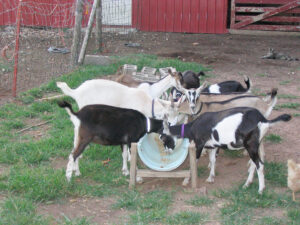
Dirty troughs are one way cocci are spread to animals. Always be sure to use clean troughs if you offer supplemental feed. Photo: NCAT
- Sericea lespedeza and other condensed-tannin-containing plants, such as birdsfoot trefoil, acacia, sainfoin, panicled tick clover, pine bark, and quebracho
- Oregano oil (Schivera, 2009)
Use of these natural compounds offers organic producers some options to mitigate the effects of coccidia. Conventional producers may also want to consider these natural alternatives, because overuse of conventional compounds may lead to resistance.
Sericea lespedeza has been shown to be effective in managing the barber pole worm and coccidia. Grazing standing lespedeza works, but if baby animals are born early in the year, sericea is not growing yet. In that case, sericea pellets (similar to alfalfa pellets) can be an effective tool. Unfortunately, these pellets are not widely available yet. The manufacturer, Sims Brothers, does not have the capacity yet to fill all orders for the pellets. Sericea hay is also effective and may be more available. One difference in using sericea to control cocci rather than barber pole worm is that the effects of the sericea are long-lasting for controlling coccidiosis, while the barber pole worm “recovers” after the host animal no longer has access to the sericea. Feeding of sericea lespedeza should occur approximately two weeks before weaning to four weeks post-weaning to maximize the positive effects and minimize the negative long-term effects, such as a potential mineral deficiency (Burke, 2014). See the “Timely Topics” archive at wormx.info for an article about using sericea to control coccidia.
Pine bark has been ground up and added to feed supplement at the rate of 30% of the diet and fed to goats. The result was not only lowered numbers of gastrointestinal parasites and coccidia, but also increased gains and improved feed efficiency (Min, 2013). Using pine bark in combination with sericea seems to be even more effective (Terrill, 2014).
Here is a caution for those using condensed-tannin (CT)–containing plants: researchers have observed that the use of tannins may bind minerals, causing deficiencies. Dr. Joan Burke (ARS) has documented reductions in the trace minerals molybdenum, selenium, copper, zinc, and manganese. Also, perhaps because of mineral problems or lower intake or some other factor, lambs and kids do not gain as rapidly after six to eight weeks of the sericea diet. To overcome these problems, you may wish to increase mineral supplementation (being mindful, however, of possible toxicity) and offer a more diverse diet. Providing pastures that include a variety of plants will improve animal intake. However, if the amount of sericea eaten is not high enough, then anthelmintic benefits may not be realized. As with all nutrition, it is important to strike a balance.
Oregano oil may be helpful in controlling coccidiosis in some instances. Producers in Maine conducted an on-farm research project (ONE08-088) using Regano (oregano oil) on sheep and goats on four different farms. Oregano oil works by the same mechanism as ionophores, like monensin (Schivera, 2009). The Maine project used young stock, beginning at four weeks of age, and fed test groups Regano with their normal ration at the rate of 2 grams/100 pounds daily. A total of 26 goats and 56 lambs were on the study. Coccidia were reduced in treated animals by 39% (sheep) and 51% (goats) (Schivera, 2009).
Two of the producers who participated in this study were pleased with results and planned to use the product again. The other two producers did not have such a positive experience. Note: Even though this treatment reduced coccidia in test groups, the reductions were not anywhere near the 95% level considered effective for dewormers.
Conclusion
As with any disease, prevention is the best cure for coccidiosis. Coccidiosis in lambs and kids can be prevented by using sanitary feeding conditions (whether feeding dams or offspring), including clean, manure-free feed troughs for supplements and not feeding supplements on the ground. Test forage quality to determine a forage’s suitability to meet the animal’s nutritional needs and, when possible, move supplementation areas to different locations to keep an area from becoming heavily contaminated with coccidia. Rotational grazing will minimize coccidiosis and minimize stress of young animals, especially at weaning.
Understanding the chemical and alternative control measures available can help producers prevent and manage outbreaks when coccidia loads are too high and illness is manifested. Consult your veterinarian for more help and for more specific information regarding timing of treatments, if needed.
Finally, notice which animals do not become ill despite equal exposure. Selecting breeding stock from those stronger animals will improve the health of the flock or herd over time and lower the contamination on the farm.
For more information on internal parasite control, including coccidia, see the website of the American Consortium for Small Ruminant Parasite Control and the publications listed above in the Related ATTRA Publications section.
References
Burke, J.M., J.E. Miller, T.H. Terrill, S.T. Orlik, M. Acharya, J.J. Garza, and J.A. Mosjidis. 2013. Sericea lespedeza as an aid in the control of Eimeria spp. in lambsVeterinary Parasitology. March 31. p. 39–46.
Burke, J.M. Research Animal Scientist, USDA Agricultural Research Service. Personal communication with author, May 2014.
Chartier, C. and C. Paraud. 2012. Coccidiosis due to Eimeria in sheep and goats, a review Small Ruminant Research. Vol. 103. p. 84–92.
Daugschies, A. and M. Najdrowski. 2005. Eimeriosis in Cattle: Current Understanding. Journal of Veterinary Medicine Series B . Vol. 52, No. 10. p.417–427.
Kommuru, D.S., T. Barker, S. Desai, J.M. Burke, A. Ramsay, I. Mueller-Harvey, J.E. Miller, J.A. Mosjidis, M. Kamisetti, T.H. Terrill. 2014. Use of pelleted sericea lespedeza (Lespedeza cuneata) for natural control of coccidia and gastrointestinal nematodes in weaned goatsVeterinary Parasitology. Vol. 204, No. 3–4. p. 191–198.
Lee, J.H., M. Vanguru, G. Kannan, D.A. Moore, T.H. Terrill, and B. Kouakou. 2009. Influence of dietary condensed tannins from sericea lespedeza on bacterial loads in gastrointestinal tracts of meat goats. Livestock Science. Vol. 126, No. 1-3. p. 314–317.
Miller, Dr. James, DVM. 2014. Louisiana State University. Personal communication with author. August.
Min, B.R. Assistant Professor, 2013. Tuskegee University. Personal communication with author. October.
Pugh, D.G. (ed.). 2002. Sheep and Goat Medicine. Saunders, an Imprint of Elsevier Science, Philadelphia, PA. p. 84–86.
Rook, J. No date. Coccidiosis in Lambs Michigan State University.
Schivera, Diane. 2009. Oregano Oil for Internal Parasite Control in Sheep, Goats, and Beef Cattle. Sustainable Agriculture Research and Education (SARE) final report. Project Number ONE08-088.
Smith, M. C., and D.M. Sherman. 1994. Goat Medicine. Lippincott Williams and Wilkins, Philadelphia, PA. p. 312–318.
Terrill, Thomas. 2014. Forage Specialist, Fort Valley State University. Personal communication with author. May.
Coccidiosis: Symptoms, prevention, and treatment in sheep, goats, and calves
By Linda Coffey, NCAT Agriculture Specialist
Published December 2014
©NCAT
IP503
Slot 503
Version 122314
This publication is produced by the National Center for Appropriate Technology through the ATTRA Sustainable Agriculture program, under a cooperative agreement with USDA Rural Development. This publication was also made possible in part by funding from the USDA, NIFA Organic Research and Education Initiative, Project No. 2010-51300-21641. ATTRA.NCAT.ORG.

